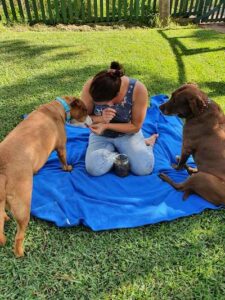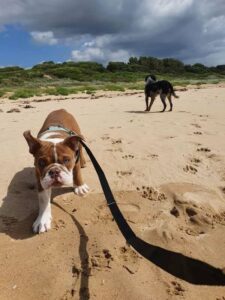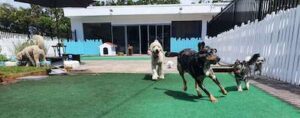Get a rockin’ recall
One of the most powerful behaviours you can teach your dog is to come when called. Recall can save your dog from running on the road, encountering a not so friendly dog at the park or allow you to have them off lead at the dog beach (the happiest place on earth if you ask me). So how do you get a rock-solid recall, I’ve listed some helpful tips below to get you on your way.
Be more rewarding than the environment
Our first step is to make sure our dog even wants to come to us. So many owners make the mistake of expecting this behaviour without having to offer anything in return. Dogs do what is reinforcing to them, so if you are out and about and there a smells and sounds and people and dogs, why would your dog want to come to you? They’ll just be put on lead, not rewarded and told to walk in a straight line…… how boring. You need to be more rewarding, more reinforcing than the surrounding environment.

Your secret weapon, the highest value treat/reward your dog’s brain can handle. It could be BBQ Chicken, cheese, or their favourite tug toy. Whatever blows your dogs mind, save this treat and only use it when you are at the dog park, dog beach, on an offlead walk in the bush or anywhere you know it’s going to be difficult for your dog to pull themselves away from the super reinforcing environment. To them, this is the only time they get this super special treat so they should want to run to you when you call their name.
Summary:
- Consider the environment you are in, you need to be more exciting to get your dog to come back to you.
- Save a very high value treat/toy for only when you and your dog are out and about, and you need them to come back to you.
Start small
Always set your dog up for success, if they are not doing a behaviour it is because they don’t understand it yet. Take some steps back, make it fun. You always want to be aware of the three D’s. Distraction, Distance and Duration. If you are somewhere really DISTRACTING then you need to reduce the other two D’s. Get closer to your dog, reduce the DISTANCE they need to come to you, only ask them to stay for a small DURATION aka give them the treat and set them free again. Mix it up between which D you are working with and remember to reduce the difficulty of the other two.
Start at home, call them from another room. When they come, act exciting, play a game, give them a treat then let them return to what they were doing and repeat sporadically.
Summary:
- Assess the Three D’s. Distraction, Distance, Duration.
- Only work on one D at a time and reduce the other two.
- Start practising recall in a low stimulus environment, at home is perfect.
Extra Tip:
Give your dog a target. By giving them something to recall to and stay on, really helps give them another layer of information on what you are asking them to do. Check out our “How to mat train your dog” blog.
Reward, even if you didn’t ask for it.
The coolest thing our dogs can do is offer a behaviour when we haven’t even asked for it. It’s easy to miss these behaviours because even we aren’t prepared. But if your dog comes back to you without being asked, REWARD THEM. Act as if they are the smartest dog on earth, because in this moment they are!! Or if you are on an off-lead walk and your dog stays by you, REWARD THEM, especially if there is something pretty cool happ

ening near by. They are choosing to stay with you, how cool is that.
Summary:
- Reward offered behaviour.
- Reward the choice to stay or engage with you when something exciting is happening near by.
Don’t just leave
It is so common to see dogs at an offlead dog park playing with their friends, having the best time, they haven’t been called back at all during their playtime and then mum or dad calls them and has a lead in hand. This means it’s home time and they’re not ready to go. It’s like when your parents are the first ones to come and pick you up from a party but youré not ready so you quickly escape to the backyard, hoping they get distracted by the other grownups and leave you to play a little longer, like an hour or two.
How do we change this behaviour? Easy, we call our dogs back, put their lead on, then take their lead off and let them go play again. (Obviously, we are giving rewards, praise, treats, toys this entire process). By taking away the pattern of mum has lead in hand, I go to mum, lead goes on, we leave, to, mum has lead in hand, mum calls, I get a treat and get to keep playing. Then, mum has lead in hand, mum calls, I get a treat, lead goes on, lead goes off, I get a treat AND get to keep playing. Heck yeah I love this lead game!!!
You can also practice this at home when you practice your recall. The more we can take the predictability away the better. Dogs are experts at learning patterns, why do you think they get excited when you put your joggers on, they know what comes next, lead then walk.
Play around with how you do things, this can relate to everything. Keep it interesting, then you stay interesting.
Summary:
- Don’t just call your dog back when it is time to leave.
- Call them back during playtime when they are off lead, then let them rejoin play.
- Reduce patterns- put there lead on, then take it off and let them free. Repeat.
Not until they are ready
Probably the most important thing you can do is not let them off lead until they are ready. In setting your dog up for success you never want to test their recall off lead until they are ready. Long leads are great for training recall, it allows your dog to have choice in their environment and it sets you both up for success because you are attached to each other. Practice recall while your dog is on a long lead, and once they come to you 100% of the time, then it’s time to let them free.

Summary:
- Keep them on a lead or long lead until they come to you 100% of the time.
- Set both of you up for success at all times.
Remember
Always set you and your dog up for success, By making ourselves rewarding, mixing up the environment and difficulty levels during practice, reducing our predictable behaviours and reinforcing behaviours we want in our dogs we can make sure that our dogs recall becomes foolproof.
To help you even further on your way, check out this super informative video by Kikopup.
So remember, stay interesting, stay rewarding, don’t be predictable and practice, practice, practice.
Happy training 🙂
